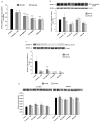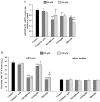p-Coumaric acid, Kaempferol, Astragalin and Tiliroside Influence the Expression of Glycoforms in AGS Gastric Cancer Cells
- PMID: 35955735
- PMCID: PMC9369150
- DOI: 10.3390/ijms23158602
p-Coumaric acid, Kaempferol, Astragalin and Tiliroside Influence the Expression of Glycoforms in AGS Gastric Cancer Cells
Abstract
Abnormal glycosylation of cancer cells is considered a key factor of carcinogenesis related to growth, proliferation, migration and invasion of tumor cells. Many plant-based polyphenolic compounds reveal potential anti-cancer properties effecting cellular signaling systems. Herein, we assessed the effects of phenolic acid, p-coumaric acid and flavonoids such as kaempferol, astragalin or tiliroside on expression of selected cancer-related glycoforms and enzymes involved in their formation in AGS gastric cancer cells. The cells were treated with 80 and 160 µM of the compounds. RT-PCR, Western blotting and ELISA tests were performed to determine the influence of polyphenolics on analyzed factors. All the examined compounds inhibited the expression of MUC1, ST6GalNAcT2 and FUT4 mRNAs. C1GalT1, St3Gal-IV and FUT4 proteins as well as MUC1 domain, Tn and sialyl T antigen detected in cell lysates were also lowered. Both concentrations of kaempferol, astragalin and tiliroside also suppressed ppGalNAcT2 and C1GalT1 mRNAs. MUC1 cytoplasmic domain, sialyl Tn, T antigens in cell lysates and sialyl T in culture medium were inhibited only by kaempferol and tiliroside. Nuclear factor NF-κB mRNA expression decreased after treatment with both concentrations of kaempferol, astragalin and tiliroside. NF-κB protein expression was inhibited by kaempferol and tiliroside. The results indicate the rationality of application of examined polyphenolics as potential preventive agents against gastric cancer development.
Keywords: MUC1; gastric cancer; glycosylation; polyphenolics.
Conflict of interest statement
The authors declare no conflict of interest. The funders had no role in the design of the study; in the collection, analyses or interpretation of data; in the writing of the manuscript; or in the decision to publish the results.
Figures












Similar articles
-
Tiliroside Combined with Anti-MUC1 Monoclonal Antibody as Promising Anti-Cancer Strategy in AGS Cancer Cells.Int J Mol Sci. 2023 Aug 22;24(17):13036. doi: 10.3390/ijms241713036. Int J Mol Sci. 2023. PMID: 37685842 Free PMC article.
-
Anti-cancer effect of combined action of anti-MUC1 and rosmarinic acid in AGS gastric cancer cells.Eur J Pharmacol. 2021 Jul 5;902:174119. doi: 10.1016/j.ejphar.2021.174119. Epub 2021 Apr 27. Eur J Pharmacol. 2021. PMID: 33930385
-
Transport of trans-tiliroside (kaempferol-3-β-D-(6"-p-coumaroyl-glucopyranoside) and related flavonoids across Caco-2 cells, as a model of absorption and metabolism in the small intestine.Xenobiotica. 2015;45(8):722-30. doi: 10.3109/00498254.2015.1007492. Epub 2015 Mar 12. Xenobiotica. 2015. PMID: 25761590
-
Role of the p-Coumaroyl Moiety in the Antioxidant and Cytoprotective Effects of Flavonoid Glycosides: Comparison of Astragalin and Tiliroside.Molecules. 2017 Jul 12;22(7):1165. doi: 10.3390/molecules22071165. Molecules. 2017. PMID: 28704976 Free PMC article.
-
Anti-Cancer Potential of Afzelin towards AGS Gastric Cancer Cells.Pharmaceuticals (Basel). 2021 Sep 25;14(10):973. doi: 10.3390/ph14100973. Pharmaceuticals (Basel). 2021. PMID: 34681197 Free PMC article.
Cited by
-
Tiliroside Combined with Anti-MUC1 Monoclonal Antibody as Promising Anti-Cancer Strategy in AGS Cancer Cells.Int J Mol Sci. 2023 Aug 22;24(17):13036. doi: 10.3390/ijms241713036. Int J Mol Sci. 2023. PMID: 37685842 Free PMC article.
-
Total Astragalus saponins promote ferroptosis in gastric cancer cells by upregulating SIRT3.Transl Cancer Res. 2025 Feb 28;14(2):1311-1322. doi: 10.21037/tcr-24-1421. Epub 2025 Feb 17. Transl Cancer Res. 2025. PMID: 40104701 Free PMC article.
-
Paradigm Shift in Gastric Cancer Prevention: Harnessing the Potential of Aristolochia olivieri Extract.Int J Mol Sci. 2023 Nov 6;24(21):16003. doi: 10.3390/ijms242116003. Int J Mol Sci. 2023. PMID: 37958986 Free PMC article.
-
Reactive Oxygen Species and H. pylori Infection: A Comprehensive Review of Their Roles in Gastric Cancer Development.Antioxidants (Basel). 2023 Sep 2;12(9):1712. doi: 10.3390/antiox12091712. Antioxidants (Basel). 2023. PMID: 37760015 Free PMC article. Review.
-
Huashi Jiedu Decoction Enhances 5-Fluorouracil Efficacy in Gastric Cancer via miRNA-21-3p/p53 Pathway.Drug Des Devel Ther. 2025 May 15;19:3883-3906. doi: 10.2147/DDDT.S513371. eCollection 2025. Drug Des Devel Ther. 2025. PMID: 40391175 Free PMC article.
References
-
- Maiuolo J., Musolino V., Gliozzi M., Carresi C., Oppedisano F., Nucera S., Scarano F., Scicchitano M., Guarnieri L., Bosco F., et al. The employment of genera Vaccinium, Citrus, Olea, and Cynara polyphenols for the reduction of selected anti-cancer drug side effects. Nutrients. 2022;14:1574. doi: 10.3390/nu14081574. - DOI - PMC - PubMed
MeSH terms
Substances
Grants and funding
LinkOut - more resources
Full Text Sources
Medical
Research Materials
Miscellaneous

